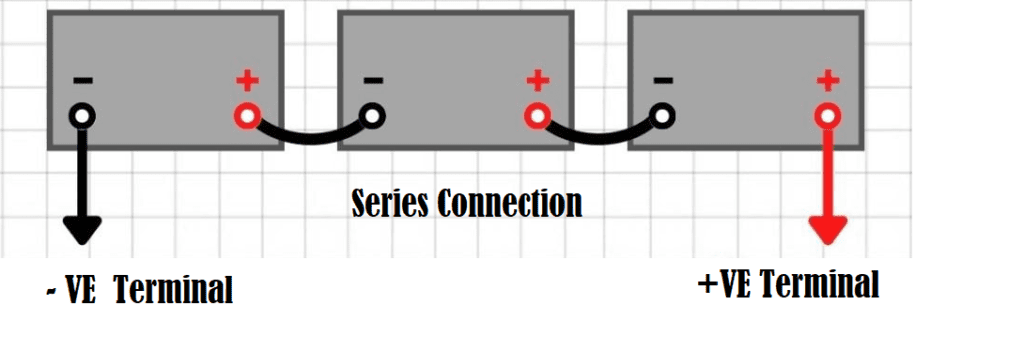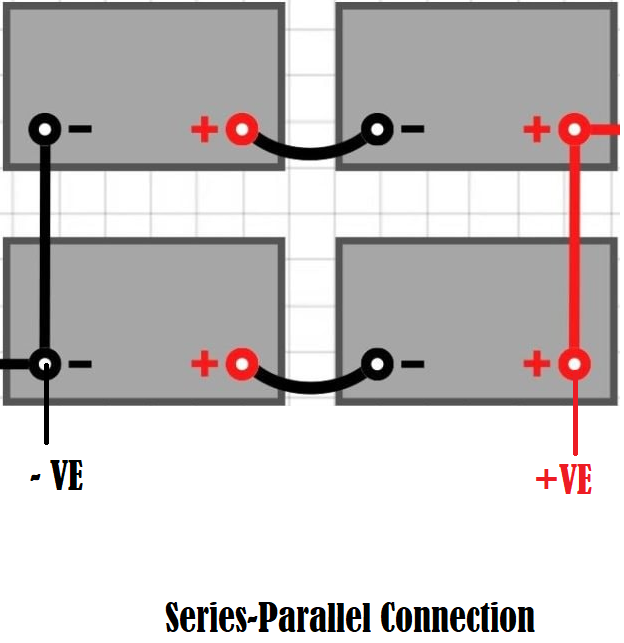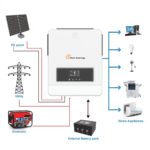Solar power systems depend on the battery bank, which connects and stores energy for later use. Correctly connecting batteries and calculating storage capacity is critical for optimal solar energy use. Let’s explore these details.
Types of Battery Bank Connections
Series Connection: Maximizing Voltage
When you connect batteries in series, the voltage output increases, which is useful for systems that require higher levels of voltage. However, it’s important to make sure that the batteries have the same capacity and age to avoid any imbalances.
“Negative Terminal of One Battery to the Positive Terminal of Another”
Advantage
- Increase the circuit’s voltage; the total voltage of the circuit is the sum of the voltages of all the batteries.
- “The current is still the same, indicating that it is the current of a single battery.”
Disadvantage
- It is essential to ensure that each battery has similar parameters, such as voltage, amperes, and rated capacity.
- A malfunctioning battery can affect the entire circuit, causing voltage drops or rendering the entire battery pack unusable.
Parallel Connection: Enhancing Capacity
Connecting the batteries’ positive to the positive and negative poles to the negative creates a parallel circuit. This circuit type increases capacity and extends the time to supply current to a device while keeping the voltage constant.
“Positive Terminal of One Battery to the Positive Terminal of Another”

Advantage
- Effectively increase the overall output current of the circuit.
- The voltage of a parallel connected battery will be the same.
- “If one of the batteries malfunctions or stops working, the other batteries will be able to continue producing power without any interruption.”
Disadvantage
- When connecting batteries in parallel, it’s important to ensure they have high consistency.
- takes longer to detect the problem.
Series-Parallel Connection: Optimizing Voltage and Capacity
Series and parallel connections can balance voltage and capacity for solar power systems. Combine series and parallel connections to create a battery bank with your desired voltage and capacity. There are multiple wiring configurations available as per your requirements.

Calculating Storage Capacity
To calculate storage capacity, consider power requirements and backup time. Multiply both to get the needed capacity. Efficiency and discharge rates are also important. Accurate calculations ensure reliable power and longer battery life.
- Determine Energy Requirements: Assess daily energy use of appliances to calculate storage capacity.
- Consider Days of Autonomy: Consider consecutive days without solar input to account for weather or low sunlight intensity.
- Account for System Losses: Calculate losses due to factors such as battery inefficiencies, inverter conversion losses, and wiring resistance. Adding a buffer for these losses ensures reliable performance under real-world conditions.
- Select Battery Type and Efficiency: Choose batteries with the right chemistry and efficiency ratings based on your system’s needs. Consider DoD and cycle life to improve performance and longevity.
- Perform Capacity calculation using the formula:
Storage Capacity = Energy Requirements × Days of Autonomy ÷ (Battery Efficiency × Depth of Discharge)
Calculate the total storage capacity needed in ampere-hours (Ah) or kilowatt-hours (kWh) to meet your system’s demands.
Transitioning to Sustainable Energy
As the world shifts towards sustainable energy, solar power systems with efficient battery banks are becoming crucial. Understanding connection types and calculating storage capacity allows individuals and businesses to achieve energy independence while minimizing their environmental impact. By optimizing solar energy utilization through careful planning and adhering to best practices, we can unlock a brighter, greener future.
FAQ
How can I charge batteries that are connected in series or parallel circuits?
When charging batteries, use a charger that matches the battery system, whether they are in series or parallel. For series charging, use a matched charger for constant current followed by constant voltage charging. Charge each battery separately if possible. Monitor the battery status consistently to prevent overcharging and over-discharging, which extends the battery’s lifespan.
What is the maximum number of batteries that can be connected in either series or parallel at once?
Connecting batteries in series increases the circuit’s voltage, but there is a limit to the number of batteries that can be connected in series. Consult the battery manufacturer for the maximum number of batteries that can be connected in series.
For example, the Delong 12V 100Ah lithium iron phosphate battery allows up to 4 batteries to be connected in series, resulting in a 48V 100Ah battery pack.
There is no limit to the number of batteries that can be connected in parallel, but several factors such as battery type and capacity, equipment requirements, application environment, and safety must be considered. Contact your battery manufacturer for confirmation or seek assistance from experienced technical personnel if unsure.
Is it possible to connect batteries with different voltages in series or parallel?
No, it is not recommended to connect batteries with different voltages in series or parallel. It can lead to imbalances, damage the batteries, and pose safety risks. It is best to connect batteries with the same voltage and similar characteristics.
Is it possible to connect batteries with different capacities in parallel?
Yes, it is possible to connect batteries with different capacities in parallel. However, it is recommended to connect batteries with similar capacities to maintain balance and optimize performance. batteries of different capacities exhibit differences in their internal resistances, current loads, charging/discharging efficiencies, and heat generation, leading to an imbalance.





